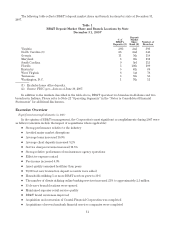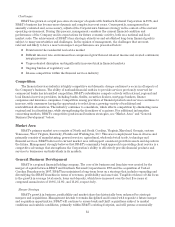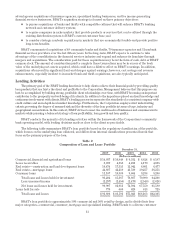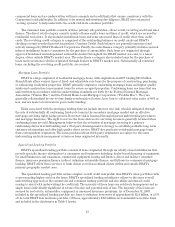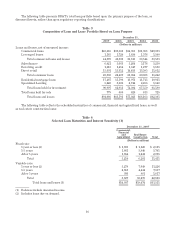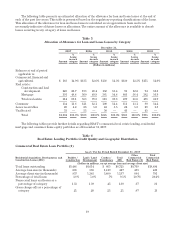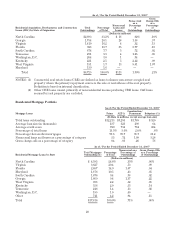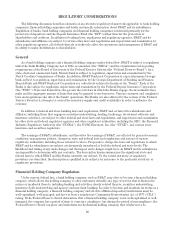BB&T 2007 Annual Report Download - page 17
Download and view the complete annual report
Please find page 17 of the 2007 BB&T annual report below. You can navigate through the pages in the report by either clicking on the pages listed below, or by using the keyword search tool below to find specific information within the annual report.
(Dollars
in millions)
(3) The above table excludes:
(i) consumer loans $11,107
(ii) real estate mortgage loans 44,687
(iii) loans held for sale 779
(iv) lease receivables 3,899
Total $60,472
Scheduled repayments are reported in the maturity category in which the payment is due. Determinations of
maturities are based upon contract terms. BB&T’s credit policy typically does not permit automatic renewal of
loans. At the scheduled maturity date (including balloon payment date), the customer generally must request a
new loan to replace the matured loan and execute either a new note or note modification with rate, terms and
conditions negotiated at that time.
Allowance for Loan and Lease Losses and Reserve for Unfunded Lending Commitments
The allowance for loan and lease losses is determined based on management’s best estimate of probable
losses that are inherent in the portfolio at the balance sheet date. BB&T’s allowance is driven by existing
conditions and observations, and reflects losses already incurred, even if not yet identifiable.
The Corporation determines the allowance based on an ongoing evaluation of the loan and lease portfolios.
This evaluation is inherently subjective because it requires material estimates, including the amounts and timing
of cash flows expected to be received on impaired loans. Those estimates may be susceptible to significant change.
Increases to the allowance are made by charges to the provision for credit losses, which is reflected in the
Consolidated Statements of Income. Loans or leases deemed to be uncollectible are charged against the
allowance. Recoveries of previously charged-off amounts are credited to the allowance.
In addition to the allowance for loan and lease losses, BB&T also estimates probable losses related to binding
unfunded lending commitments. The methodology to determine such losses is inherently similar to the
methodology utilized in calculating the allowance for commercial loans, adjusted for factors specific to binding
commitments, including the probability of funding and exposure at funding. The reserve for unfunded lending
commitments is included in accounts payable and other liabilities on the Consolidated Balance Sheets. Changes to
the reserve for unfunded lending commitments are made by charges or credits to the provision for credit losses.
Reserve Policy and Methodology
The allowance for loan and lease losses consists of (1) a component for individual loan impairment recognized
and measured pursuant to Statement of Financial Accounting Standards (“SFAS”) No. 114, “Accounting by
Creditors for Impairment of a Loan,” and (2) components of collective loan impairment recognized pursuant to
SFAS No. 5, “Accounting for Contingencies,” including a component that is unallocated. BB&T maintains specific
reserves for individually impaired loans pursuant to SFAS No. 114. A loan is impaired when, based on current
information and events, it is probable that BB&T will be unable to collect all amounts due (interest as well as
principal) according to the contractual terms of the loan agreement. On a quarterly basis, BB&T reviews all
commercial lending relationships with outstanding debt of $2 million or more that have been classified as
substandard or doubtful. Loans are considered impaired when the borrower does not have the cash flow capacity
or willingness to service the debt according to contractual terms, or it does not appear reasonable to assume that
the borrower will continue to pay according to the contractual agreement. The amount of impairment is based on
the present value of expected cash flows discounted at the loan’s effective interest rate, and/or the value of
collateral adjusted for any origination costs and nonrefundable fees that existed at the time of origination.
Reserves established pursuant to the provisions of SFAS No. 5 for collective loan impairment are primarily
based on historical charge-off experience using a rolling twelve quarter annualized net charge-off rate. However,
historical charge-off experience may be adjusted to reflect the effects of current conditions. BB&T considers
information derived from its loan risk ratings; internal observable data related to trends within the loan and lease
portfolios, including credit quality, concentrations, aging of the portfolio, growth and acquisitions; volatility
adjustments to reflect changes in historical net charge-off rates and changes in probabilities of default; external
17






